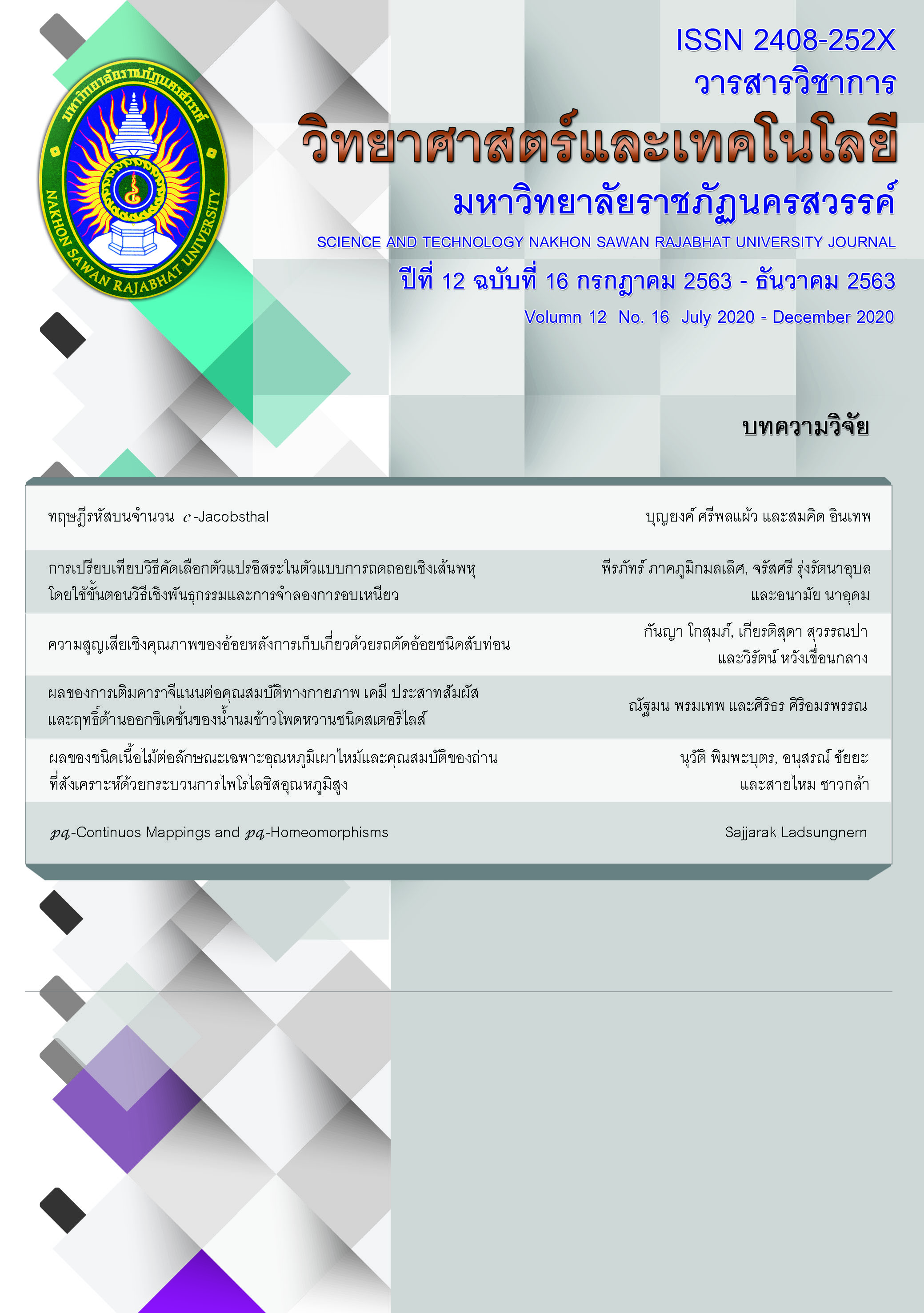ผลของชนิดเนื้อไม้ต่อลักษณะเฉพาะอุณหภูมิเผาไหม้และคุณสมบัติของถ่านที่สังเคราะห์ด้วยกระบวนการไพโรไลซิสอุณหภูมิสูง
Main Article Content
Abstract
This research aims to study the effects of wood type on characteristics of combustion temperatures and properties of charcoal synthesized by pyrolysis process with small inverted downdraft kiln. The waste woods; i.e.: bamboo chopsticks, coconut shells, eucalyptus and acacia were used as raw materials. The combustion characteristic was investigated by measuring the temperature inside the kiln as a function of time. The percent yield was obtained from ratio between mass of synthesized charcoal to mass of raw wood. The charcoal properties such as apparent density, moisture content, volatile gas and ash content were measured by ASTM standard methods which used for reveal fixed carbon. The charcoal heat value was measured by Bomb calorimeter. The results showed that the characteristic of the combustion temperature depend on type of wood. The maximum temperatures during combustion process were 827 oC, 693oC, 624oC and 597oC for acacia, bamboo chopsticks, coconut shells and eucalyptus, respectively. The maximum percent yield of charcoals was 28.0% obtained from bamboo chopsticks and coconut shells, second value of 27.0% from eucalyptus and minimum value of 24.0% from acacia. The fixed carbon of coconut shells, eucalyptus, acacia and bamboo chopsticks was 45.9%, 41.6%, 36.5% and 30.4%, respectively. The heat values were found to be 32.49-33.23 kJ/g. According to the study, the percentage of fixed carbon depends on the type of the wood, which high density showed high carbon content. The results of heat value of all synthesized charcoal showed high heat values with small amount heat different indicated that the charcoal obtained by using pyrolysis process of inverted downdraft kiln possibly well remove non-carbon components from the wood.
Article Details
References
เจือจันทน์ เกตษา. (2556). ผลของอุณหภูมิคาร์บอไนเซชันต่อสมบัติของถ่านชาร์และถ่านกัมมันต์ จากกะลามะพร้าว. (วิทยานิพนธ์ปริญญา วิศวกรรมศาสตรมหาบัณฑิต). มหาวิทยาลัยเทคโนโลยีสุรนารี, สาขาวิชาวิศวกรรมเคมี.
ชลลดา ไร่ขาม, ยุทธพันธ์ คำวัน, ปภาภร จันทะวงศ์ฤทธิ์ และศิริทรัพท์ แก้วม่วง. (2560). ศึกษาอิทธิพลของอัตราส่วนกากน้ำตาลที่มีผลต่อคุณสมบัติของถ่านเชื้อเพลิงอัดแท่งที่ทำจากเปลือกมังคุดและเปลือกเงาะ. วารสารวิชาการ วิทยาศาสตร์และเทคโนโลยี มหาวิทยาลัยราชภัฏนครสวรรค์, 9 (10), 80-90.
ธีรพจน์ พุทธิกีฏกวีวงศ์, เจษฎานันท์ เวียงนนท์ และภัทราวดี ศรีบุญสม. (2549). การผลิตถ่านอัดแท่งจาก้นถั่วเหลือง. Naresuan University Journal, 14 (3), 11-18.
พนิตา สุมานะตระกูล, จตุพร แก้วอ่อน, ปาริชาติ เทพทอง และพลากร บุญใส. (2555). การเพิ่มประสิทธิ ภาพเตาเผาเพื่อผลิตถ่านและน้ำส้มควันไม้จากไผ่ตงลืมแล้ง. รายงายวิจัยฉบับบสมบูรณ์มหาวิทยาลัยทักษิณ.
พิสิษฏ์ มณีโชติ, ประพิธาร์ ธนารักษ์, สหัถยา ทองสาร, บงกช ประสิทธิ์, วิกานต์ วันสูงเนิน, ประวิทย์ นิลวิเชียร, อันธิกา เพชรลี และอนุพล อัคพิน. (2558). การพัฒนาเตาเผาถ่านขนาด 200 ลิตร แบบแนวตั้ง ด้วยเทคนิคแก๊สซิฟิเคชั่น. ประชุมเชิงวิชาการรูปแบบพลังงานสู่ชุมชนแห่งประเทศไทยครั้งที่ 8 ประจำปี พ.ศ. 2558 (หน้า 114-117). กรุงเทพ ฯ: คณะวิศวกรรมศาสตร์ มหาวิทยาลัยราชมงคลธัญบุรี.
วรัญญา เทพสาสน์กุล, วรัญญา ธรรมชาติ, และอัครินทร์ อินทนิเวศน์. (2559). การศึกษาเชื้อเพลิงอัดแท่งที่ผ่านกระบวนการคาร์บอไนเซชันจากวัสดุเหลือทิ้งทางการเกษตรประเภทกะลามะพร้าว. การประชุมวิชาการเครือข่ายพลังงานแห่งประเทศไทยครั้งที่ 12 (หน้า 610-617). พิษณุโลก: โรงแรมวังจันทร์ ริเวอร์วิว คณะวิศวกรรมศาสตร์ มหาวิทยาลัยราชมงคลธัญบุรี.
วิรัตน์ เจริญบุญ. (2560). เตาชีวมวลแกลบพลังงานเพื่อเกษตรกรไทย. วารสารวิทยาศาสตร์ มข, 45 (1), 163-174.
สิริลักษณ์ ตาตะยานนท์. (2549). การศึกษาเปรียบเทียบและทดสอบความแตกต่างของค่าความร้อนของไม้ 18 ชนิด. รายงานผลวิจัยประจำปี 2549 (หน้า 199-208). สำนักงานวิจัยการจัดการป่าไม้และผลผลิตป่าไม้.
สำนักงานมาตรฐานผลิตภัณฑ์อุตสาหกรรม. 2547 (ข). มาตรฐานผลิตภัณฑ์ชุมชน ถ่านไม้หุงต้ม. [online] เข้าถึงจาก http://www.charcoal.snmcenter.com/charcoalthai/standard2.php. สืบค้นเมื่อ 13 เมษายน พ.ศ.2563.
อนุรักษ์ ตรีเพ็ชร, ปริญญา หม่อมพิบูลย์, เฉลิมขวัญ สมใจ, มนตรี เรืองประดับ, เปมิกา แซเตียว และณปภัช จันทร์เมือง. (2559). เชื้อเพลิงแก๊สซิฟิเคชันจากวัสดุเหลือใช้ทางการเกษตร เพื่อผลิตไฟฟ้า: อีกทางเลือกของพลังงานทดแทนของภาคใต้. วารสารวิชชา มหาวิทยาลัยราชภัฏนครศรีธรรมราช, 35 (1), 13-25.
อรทัย วงษาเวียง, มาลีวรรณ อุนพิพัฒน์, ชลธิชา เจริญเนตร, และเอกราชันย์ ไชยชนะ. (2559). ไพโรไลซิสของวัสดุเหลือทิ้งทางการเกษตรในท้องถิ่นจังหวัดนครปฐม.วารสาร สหวิทยาการไทย, 11 (3), 46-53.
American Society for Testing and Materials (ASTM). (1996). Standard Test Method for Gross Calorific Value of Coal and Coke by the Isoperibol Bomb Calorimeter: D3286-96 In ASTM. Annual Book of American Standard Testing Methods, Vol 05.06.
American Society for Testing and Materials (ASTM). (2000). Standard Test Method for Moisture in the Sample of Coal and Coke1: ASTM D3173-00. Annual Book of ASTM Standards, Vol 05.05.
American Society for Testing and Materials (ASTM). (2002). Standard Test Method for Ash in the Analysis Sample of Coal and Coke from Coal1: D3174-02 in ASTM. Annual Book of ASTM Standards, Vol 05.06.
American Society for Testing and Materials (ASTM). (2002). Standard Practice for Proximate Analysis of Coal and Coke1: D3172-89 in ASTM. Annual Book of ASTM Standards, Vol 05.05.
American Society for Testing and Materials (ASTM). (2002) . Standard Test Method for Volatile Matter in Analysis Sample of Coal and Coke1: D3175-02 in ASTM. Annual Book of ASTM Standards, Vol 05.05.
El-Juhany L. I., I. M. Aref and M. M. Megahed. (2003). Properties of charcoal produced from some endemic and exotic acacia species grown in Riyadh, Saudi Arabia. Adv. agric. Res. 8(4), 695-704.


